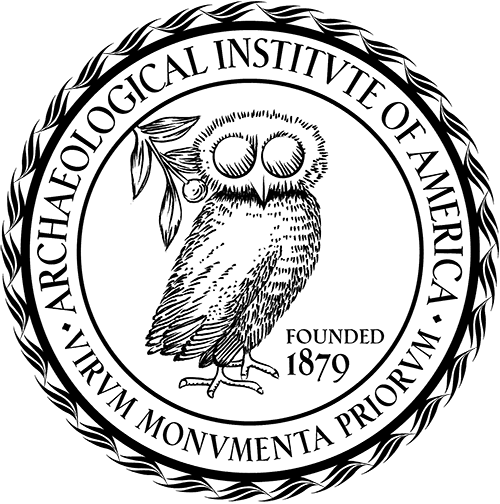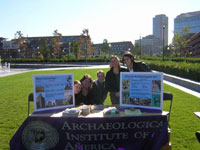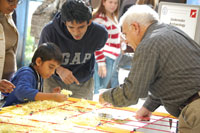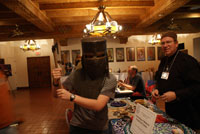November 1, 2008

This past October was a busy, exciting month for the AIA’s Outreach and Education Department. October is Massachusetts Archaeology Month and we helped kick it off by joining Boston’s Museum of Science, Boston City Archaeologist Ellen Berkland (see “Digging Under Beantown“), the Massachusetts Historical Commission, and Charles and Rosalie Baker of Dig and Calliope magazines to present an archaeology activity area at the inaugural celebrations of the Rose Kennedy Greenway in Boston on October 4, 2008. The Greenway occupies the stretch of land that once supported the elevated roadways that were relocated underground by Boston’s infamous “Big Dig.” The Greenway celebrations attracted thousands of people, many of whom visited our activity area prominently located next to the historic North End district and near the City Archaeology Lab.

The AIA presented a display of posters and hand-outs that discussed archaeology and “what archaeologists do.” The table was staffed by Outreach and Education Assistants, Jessica MacLellan and Samantha Stein along with volunteers from Boston University’s Archaeology Club. Boston’s City Archaeologist, Ellen Berkland, and the Massachusetts Historical Commission brought in a reconstruction of a 17th-century privy excavated in the area during the Big Dig and featured a historical re-enactor who answered questions dressed as Katherine Nanny Naylor, the privy’s original owner. Michael Adams from the Museum of Science and other museum educators highlighted a millstone excavated in the area by creating a hands-on demonstration of the science behind millstones. Participants were able to see how ancient mills worked and even grind their own corn. Charles and Rosalie Baker of Dig and Calliope magazines presented two popular hands-on activities: “Making Mosaics” and “A Dig in Your Backyard.” (See our lesson plans for other activities and simulated excavations.) In conjunction with these activities, an open house was held at the nearby City Archaeology Lab. More than 1,000 people, including families with children, visited the archaeology presentations. Click here for a pdf version of the flyer for this event.
A week after the Greenway celebrations we hosted the Second Annual AIA-MOS Archaeology Fair at Boston’s Museum of Science on October 10 and 11, 2008. The Fair was sponsored in part by a grant from the Massachusetts Foundation for the Humanities. On Friday, October 10, the fair was open mainly to school groups. More than 2,000 students, teachers, and chaperones attended the program on that day. The majority of the students were middle schoolers. In an effort to increase the age and grade diversity of the students attending the Fair, the Massachusetts Foundation for the Humanities and the AIA jointly covered the cost of attendance for 400 Boston-area elementary and high-school students. On Saturday, the fair was open to the general public and the MOS estimated that around 2,500 people attended the fair on that day giving us a total of approximately 4,500 people over the two-day period.

The two-day fair built on the success of last year’s event. This year we had more presenters and more activities. Most of last year’s presenters returned and we welcomed several new organizations to the fair and hope that they will all become regular presenters at this event. Archaeologists and museum educators from around New England presented 22 different activities–eight more than in 2007. Popular programs included: “Make a Colonial-Era Toy” by the American Textile History Museum, an activity on Maya hieroglyphic writing by Harvard’s Peabody Museum, and “Clues to the Native American Past” by the Massachusetts Archaeological Society & Robbins Museum. A complete list of presenters and their activities is included below. Click here for a pdf version of the flyer for this event.
This year’s fair was preceded by a week of archaeological programs at the Museum of Science that included hands-on activities and live presentations. A popular addition to the first day of the fair was a special evening program on ancient astronomy designed by Mike Adams and the MOS staff and presented at the museum’s planetarium. The show was followed by a session of star-gazing through telescopes set up on the museum’s roof.
Special thanks to Mike Adams of the Museum of Science for making the 2007 and 2008 fairs possible. We look forward to the Third Annual AIA-MOS fair next October!
AIA co-sponsored the Second Annual Maya at the Playa conference with American Foreign Academic Research, October 2-5, in Palm Coast Florida. The brainchild of Mat Saunders, AIA’s VP of Outreach and Education, Maya at the Playa is a celebration of all things Maya. A public outreach event, the conference brings together leading Maya scholars for four days of lectures and workshops. This years event included presentations on the Maya calendar, the significance of 2012, workshops on Maya writing, music, folklore, stone tool production, talks on various aspects of ancient Maya culture (including sacrifice, Maya queens, and cave archaeology) and a demonstration of the Mesoamerican ballgame.
The majority of the people attending the conference were local teachers and students. Several members of the public also attended the meeting and we even had a few international visitors. Presenters included leading Mesoamerican archaeologists and other experts. The program also featured Maya musicians (playing traditional instruments) and storytellers. The event was a fantastic opportunity for attendees to learn about Maya culture and traditions from experts. As part of our co-sponsorship, the AIA offered free membership for a year to all attendees and presenters at the event.
Several months of planning culminated in a fantastic Archaeology Festival held in Santa Fe, New Mexico, on November 1st in conjunction with the AIA’s Governing Board Meeting. This was the first time that such a meeting featured a public outreach event. The festival was free to the public and drew about 250 visitors. Archaeologists and museum educators from New Mexico and around the country presented 20 different activities. Highlights included historic re-enactors from Roman Legion XIV, Boston Museum of Science’s “Ancient Astronomers of the Southwest,” demonstrations of traditional Native American pottery-making and yucca sandal-making by the New Mexico Office of Archaeological Studies, a presentation on medieval archaeology by Michael Fuller of St. Louis Community College, and a dendrochronology (tree-ring dating) activity by Cibola National Forest educators. A complete list of presenters is included below. Click here for a pdf version of the flyer for this event.

The presentations were exceptionally diverse and the range of topics presented at the event was outstanding. By all accounts, the Santa Fe Archaeology Festival was a rousing success. Fair attendees were happy with the variety of the presentations and all were thrilled with the hands-on. Several parents with young children in tow commented on the engaging nature of the presentations and spent several hours at the fair moving from one to the next. Our presenters enjoyed meeting members of the public as well as visiting their fellow presenters’ tables. The AIA Board members and trustees who attended the event were excited about the event and thrilled that they were able to participate and meet the presenters.
Special thanks to Sidney Barteau and the Santa Fe society of the AIA who were helpful in providing us with contacts at the newspapers and even got us a front-page article in the Albuquerque Journal on the day of the fair. Thanks also to our hosts at the La Fonda Hotel who were helpful and accommodating. Their staff was always ready and willing to find an extra chair for a presenter.
Second Annual AIA-MOS Archaeology Fair Presenters
American Textile History Museum–Make a Colonial Era Toy!
Assoc. for Gravestone Studies–Etching on Slate and Making Gravestone Rubbings
Board of Underwater Arch Resources–Underwater Archaeology
Boston Childrens Museum–Exploring Colonial New England
Boston’s City Archaeology Program–I Want to be an Archaeologist
Dig and Calliope Magazines–Mosaic Magic, A Dig in Your Backyard, Canine Archaeology
Discovery Museums–Pound Like an Egyptian: Papyrus Papermaking
Franklin Pierce Anthropology Club–Understanding Atlatls
Harvard Peabody Museum–Magnificent Maya
Joe McKendy-MAS/Robbins Museum–Clues to the Native American Past
Old Sturbridge Village-From the Ground Up
Plimoth Plantation–Exploring Stratigraphy
Public Archaeology Lab (PAL)–Time Scene Investigations
Robert S. Peabody Museum of Archaeology–Pseudomorphs
Robert S. Peabody/Brandeis–Bones, Stones, & Spears: Evolution of the Early Human Body & Mind
Semitic Museum–Near Eastern Archaeology
Strawbery Banke Museum–Solving the Mysteries of Strawbery Banke
UMASS Archaeological Services–Public Archaeology in New England
UMass Boston–Under Our Feet: Using Geophysics to Read the Record of History in Rocks and Sand
Santa Fe Archaeology Festival Presenters
Archaeological Institute of America–Mesoamerican Ballgame, Ancient Writing Systems, AIA Info Table
Archaeology Magazine–Adolph Bandelier: The Proper Person
Archeological Records Management Section (ARMS) Historic Preservation Division, Dept. of Cultural Affairs–Prehistoric Rocks and Roles
Cibola National Forest–Hands On Dendrochronology
Friends of Tijeras Pueblo–Tijeras Pueblo Archaeological Site
Local Fiber Friend–Fiber Spinning
Maxwell Museum of Anthropology–Southwest Archaeology, Ancient Tools, and Technology
Milwaukee Public Museum–Obelisks and Rulers
Museum of Indian Arts and Culture & Laboratory of Anthropology–A Treasure for Researchers and the Public
Museum of New Mexico–Treasure Trunks and Cuneiform
Museum of Science–Ancient Astronomers of the Southwest
New Mexico Office of Archaeological Studies–New Mexico Archaeology and Lifeways
OAS – Native American Pottery–Replication of Rio Grande Glaze Ware Pottery
Passport in Time Clearinghouse, SRI Foundation–The Archaeology Laboratory
Roman Legion XIV–Ancient Roman Life
Santa Fe Society of the AIA–Santa Fe Archaeological Society
School for Advanced Research (SAR)–Archaeological Outreach at SAR
Southwest Archaeological Consultants, Inc.–GIS: An Educational/Research Tool for Archaeology and History
St. Louis Community College–Archaeology of Medieval Knights and Castles
Texas A&M Nautical Archaeology–Drawing the Bow in Antiquity
University of New Mexico–Be a Junior Archaeologist